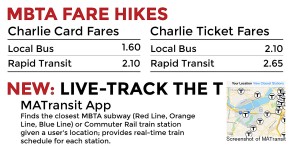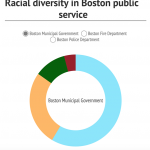
As students at Boston-area colleges and universities begin commuting throughout the city for another academic year, the Massachusetts Bay Transportation Authority has increased fare prices, extended service hours and created live-tracking applications for their train and bus services.
As of July 1, fares have increased by5 percent. Subway costs have increased from $2.00 to $2.10 with a CharlieCard and from $2.50 to $2.65 with a CharlieTicket.
The MBTA’s bus service now costs $1.60 with a CharlieCard, an increase from $1.50, and $2.10 with a CharlieTicket, increased from $2.00.
The cost of Boston University students’ MBTA semester pass has also increased by $18, from $249 to $267, according to BU’s Parking & Transportation Services website.
“The MBTA needed to close a gap in its Fiscal Year 2015 budget, which took effect July 1,” said MBTA spokesman Joe Pesaturo in an email. “The revenue from the modest fare adjustment has helped the MBTA balance its budget.”
Theresa Kniaz, a sophomore in the School of Mana
gement, said the fare increase could cause a decrease in ridership and an increase in car use.
“More people need to be off the highways and out of their cars, and with the price increase, that won’t happen,” she said. “If they choose to raise the prices, then we should actually be seeing the improvements in the quality of the trains and buses and in the quality of our rides. It’s definitely affected how often I take the T.”
Anthony Marotta, 57, of Back Bay, said although he understands why the MBTA has increased fare prices, he is now forced to allot more money from his already tight budget in order to ride the T.
“It’s very inconvenient because I’m on a disabled income,” he said. “It’s very expensive. I probably spend over $50 a month on public transportation, which is money that I could use towards food. I understand that prices have gone up for everything. It’s become a way of life. Things are just totally different. If prices went up again, I would have to limit my use of public transportation significantly.”
Revenue from late-night service
The MBTA has also been able to raise funds through the addition of late-night service, which Pesaturo said is in the midst of a yearlong pilot program.
“Since the pilot program began in late March, more than 450,000 riders have used the late night service between 12:30 a.m. and 3 a.m. on Saturdays and Sundays,” he said. “Ridership varies from weekend to weekend, but it generally stays in the range between 15,000 and 18,000 per weekend.”
At the conclusion of the pilot-program, Pesaturo said the MBTA will make a decision on whether to continue late-night service based on the revenue they generate or to implement different budget-related strategies.
Tim Shyshpar, a senior in SMG, said the extended service is the better, safer option for late-night commuters, but it could also be a disturbance for some who live near the tracks or bus stops.
“For some it might potentially be a disturbance, but it’s better than walking at night, especially if that person is coming back from Allston,” he said. “The T might not be the safest option, but it’s safer, more the less.”
MBTA incorporates live-tracking technology
The MBTA has been working with technology developers to create more than 20 live-tracking smartphone and computer applications, allowing users to locate MBTA trains and buses nearest to them.
Ming Chow, a computer science professor at Tufts University’s School of Engineering, was able to create the app MATransit using MBTA data and documentation.
“The MBTA has the real-time train schedules publicly available,” Chow said in an email. “So each time a person clicks on a station on my app, the app makes a connection to my server to retrieve closest stations and lines, then the server gets the schedule for each station. The information is then transferred back to the user’s phone.”
Nicole Landa, 28, said while live-tracking apps are useful, they are not a primary concern for those riding the T.
“The applications are helpful, but also possibly discouraging to see how long it will take for the T to get here,” she said. “Especially because sometimes it takes longer for the T or the bus to arrive than we may like. With the expansion of the city, there are still so many places that are not accessible, like the waterfront.”




